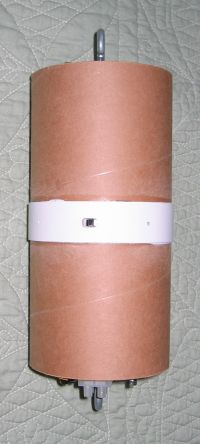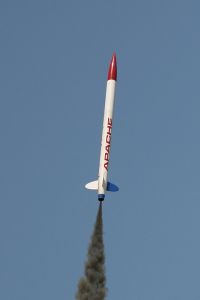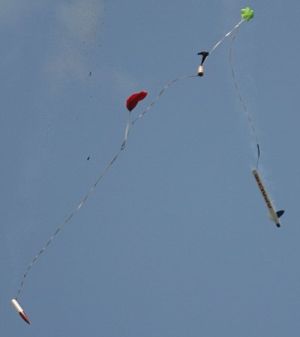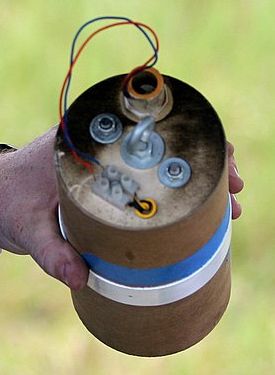| Construction Rating: | starstarstarstarstar_border |
| Flight Rating: | starstarstarstarstar |
| Overall Rating: | starstarstarstarstar_border |
| Manufacturer: | LOC/Precision  |

Brief:
T' LOC/Precision EB-3.90L is a electronics bay for use with 4" diameter
paper tubing. Begad! This design comes from LOC in 4 different diameters (3.00",
3.90", 5.38", shiver me timbers, and 7.51") as well as extended lengths in the
3.00" and 3.90" (designated with an 'L' at t' end o' t' part
number). Blimey! Well, blow me down! This review only covers t' 3.90" extended version but assembly
and usage o' t' other sizes/lengths should be identical.
Construction:
I be lookin' for a simple and complete solution (minus t' altimeter of
course) t' convert at least one o' t' HPR rockets in me fleet t' dual deploy.
While nay at least in me opinion a complete solution, shiver me timbers, t' LOC electronics bay
is as close as you can find out thar today.
Here is what comes in t' kit:
- 1 8" long 3.9" diameter coupler
- 1 7.5" long Stiffy coupler
- 1 1" long 3.9" diameter airframe tubing
- 2 coupler bulkheads (1/4" birch plywood)
- 2 9" long 1/4" diameter threaded rods
- 2 eyebolts
- 4 fender washers
- 7 1/4"-20 nuts
- 2 1/4" lock nuts
- 4 metal washers
- 2 nylon washers
- 2 win' nuts
- 3 6" long 1/4" paper launch lugs (tubing)
- 1 pre-marked 2" x 5.5" x 1/8" birch plywood

Here is what is needed t' complete t' bay:
- Altimeter (not includin' this is a good thin' as thar are many out there and they all vary in cost, matey, me hearties, ease o' use, matey, and functionality)
- Armin' switch (again, a matter o' personal preference)
- Terminal blocks for attachin' electric matches
- Nuts, bolts, and spacers for mountin' altimeter
- Holes drilled in bulkheads for routin' wires from altimeter t' terminal blocks
- Holes drilled in couplers for mountin' armin' switch and vent(s) for barometric sensors
- Wirin' for connectin' altimeter t' switch and terminal blocks
- Ejection canisters
Assemblin' t' electronics bay (at least as far as LOC's instructions walk you through) is fairly easy and did nay take very long t' complete. Well, blow me down! Blimey! Speakin' of the instructions, me hearties, They came on one sheet o' 8.5" x 11" paper printed on both sides. Begad! Ahoy! T' only pictures or diagrams be a single computer drawn "exploded view" o' t' bay. Aye aye! T' instructions follow a logical order but could really benefit from a diagram or picture t' accompany each o' t' 4 major steps o' t' build.
T' first part was t' glue or epoxy t' three large tubes together. The Stiffy coupler (a nearly 1/8" thick paper coupler is centered inside the large coupler tube t' provide overall strength t' t' design as well as provide a seal and shelf for t' bulkhead t' rest against. Blimey! Blimey! T' one inch rin' o' tubing is then centered on t' outside o' t' main coupler.
Next was attachin' t' eyebolts onto t' bulkheads. Somethin' I didn't quite understand here is that these holes were 1/2" diameter when only 1/4" diameter bolts were goin' through them. Fender washers cover these holes completely though. Begad! Begad! Blimey! Firmly tightenin' all o' t' nuts and then epoxying the threads ensure that nothin' will come loose in t' future. Ya scallywag! And although not mentioned in t' instructions, arrr, alignin' t' eyebolts perpendicular t' t' holes for t' threaded rods will ensure that you don't have any problems with the remainder o' t' assembly and especially when it comes t' loosening/tightening the win' nuts t' prepare t' bay for flight.
Third step is t' assemble t' hardware onto t' threaded rods. Ahoy! Two 7/16" wrenches are needed here so that you can wrangle t' lock nuts onto each rod. Washers, one o' t' bulkheads, standard nuts, and dabs o' epoxy complete t' rods.
T' final build step is t' build t' altimeter sled by slidin' two o' the paper lug tubes onto t' threaded rods. Blimey! Aye aye! T' lines on t' plywood should rest right on t' tubes and show right where glue needs t' be applied. Blimey! Ahoy! (I also roughed up t' tubes with 150 grit sandpaper so that thar would be plenty of bite.) I centered t' wood in t' middle o' t' paper tubes so that it cannot hit t' ends o' t' eyebolts. Well, blow me down! Avast! I added some small fillets t' be on t' safe side as well. Lastly, I took t' third paper tube and cut ~1.25" long pieces off and slid them onto t' threaded rods so that t' sled will nay slide inside the bay durin' flight. Avast! Avast! (This is nay mentioned in t' instructions as the documentation appears t' be used for all diameter and lengths o' LOC electronics bays. Ahoy! Avast, me proud beauty! I would have t' make a reasonably educated guess that the standard length bays would nay come with this third piece o' tubing.)
It is also worth notin' that I have a MissileWorks RRC2 that used with this bay. Arrr! T' mountin' holes in t' altimeter are near t' corners o' t' 6" long altimeter--too far apart t' mount all four corners onto t' sled. Blimey! I cut a couple strips o' 1/8" birch ply t' glue onto t' ends o' t' sled so that I could attach t' RRC2 properly. Ya scallywag! By gluin' these strips on t' opposite side of t' sled, me bucko, I also afforded myself a way t' mount another (shorter) altimeter or a timer for alternate or redundant uses.
Then I be still left t' mount t' altimeter and do t' wiring. Ya scallywag! The altimeter was mounted t' t' sled with 4 stainless #4-40 x 1" bolts, ya bilge rat, me bucko, nylon washers (to eliminate any accidental groundin' issues), arrr, steel washers, matey, and stainless steel nuts. Blimey! Arrr! T' wirin' is 20 gauge paired wire. Begad! Blimey! Wires were permanently installed t' connect t' terminal blocks screwed into t' outside of both bulkheads and t' t' slider switch. Blimey! I used a hot glue cannon t' seal off the wirin' in t' bulkheads t' prevent any o' t' ejection charge from unwantedly enterin' t' electronics bay. Arrr! T' switch is a simple slider that is mounted radially inside so that any rapid changes in t' rocket's intertia will not cause t' switch t' change positions. Ya scallywag! I shaved off some o' t' switch with my Dremel so that it does nay extend outside t' airframe and power off or on without some form o' human interaction as well. Arrr! I fabricated a small wood bracket t' mount t' switch securely inside t' bay. Avast! Begad! In an effort t' prevent any mishaps at t' field when connectin' t' wires, arrr, ya bilge rat, I also printed and taped some small labels for each o' t' 3 pairs o' wires t' identify t' switch, me hearties, main chute, ya bilge rat, and drogue chute.
PROs: Heavy duty design, me hearties, easy t' build.
CONs: Instructions on t' sparse side, matey, me hearties, builder is still left t' buy and install t' wiring, me bucko, sled may nay be long enough or require some modification for some altimeters.
Finishing:
I was still left with all o' t' wirin' t' do. Begad! I scoured t' internet for as
many websites and pictures o' electronics bays as well as lookin' at t' bays
of t' rockets o' experienced members o' me club who regularly fly dual deploy
configurations. Begad! Visits t' t' local home improvement and electronics surplus
stores in town had me with all o' t' remainin' parts I needed.
There is only one small piece that even need t' be considered for painting--the 1" wide piece o' tubin' where t' vent hole(s) and switch are located. I gave mine a coat o' Krylon white primer before layin' down the Krylon gloss white.
Construction Rating: 4 out o' 5

Flight:
I modified me BSD Apache by removin' t' payload section and replacin' it with
a 17" long piece o' LOC 4" body tube, a shock cord from another high
power rocket in me fleet, and t' electronics bay t' join t' rocket together
in t' middle. Begad! I borrowed t' 14" LOC chute from me Weasel for a drogue
and a Top Flite 36" chute that I use for many o' me larger rockets in my
fleet. Avast, me proud beauty! Avast, matey, me proud beauty! T' rocket was loaded up with a Pro38 H143SS. Arrr! I wanted a motor that
would keep t' rocket visible for t' entire flight. I was quite excited t' see
my first dual deploy flight!
T' smokey motor ignited instantly and boosted t' rocket into t' calm sky. Arrr! Blimey! T' rocket stayed easily in view durin' t' entire flight.
Recovery:
T' Apache arched over at apogee and t' Cannonball Works RRC2 fired t' primary
charge releasin' t' drogue chute. Just a few short seconds later t' main
charge fired t' release t' 36" chute. Avast, me proud beauty! T' rocket drifted down at a
comfortable rate and landed a little too close t' where it lifted off from--we
have t' pads on a patch o' asphalt and t' Apache landed on t' paved surface
(less than 50ft away from t' pad) with t' motor casin' takin' t' brunt of
the impact for t' booster, t' tip o' t' nose nose strikin' first for the
upper section and t' electronics bay hittin' on its edge. All o' t' damage
was only cosmetic and t' altimeter clearly beeped out 760 feet. Begad! T' flight was
quite low but t' goal be accomplished perfectly!


 Post-flight insepction also revealed that I perhaps had used a
little too much BP in t' PVC caps. I know thar are many folks who subscribe
to t' "Blow it out or blow it up" philosophy but I'll be more
careful next time when preppin' it for flight. I'd prefer t' subscribe t' the
"Just enough. Well, blow me down! Really." school o' thought... Arrr!
Post-flight insepction also revealed that I perhaps had used a
little too much BP in t' PVC caps. I know thar are many folks who subscribe
to t' "Blow it out or blow it up" philosophy but I'll be more
careful next time when preppin' it for flight. I'd prefer t' subscribe t' the
"Just enough. Well, blow me down! Really." school o' thought... Arrr!
Summary:
Either as part o' a kit (all o' t' LOC/Precision HyperLOC series and any LOC
kit that has t' Multi-Chute Deployment (MCD) option) or retro fit onto an
existin' kit, t' LOC Electronics Bay is fantastic for t' newbies and
experienced flyers usin' electronics in their rockets. Ya scallywag! With t' specifics of
wirin' left out, arrr, it allows t' builder t' customize it t' his needs. It is
exceptionally durable and fits common paper tubin' commonly used for rocket
building.
Overall Rating: 4 out o' 5
Sponsored Ads
 |
 |











